
Arizona is a state known for its stunning natural landscapes, from the majestic Grand Canyon to the towering saguaro cacti of the Sonoran Desert. However, beyond its breathtaking outdoor wonders, Arizona also boasts a rich architectural heritage that reflects its unique history and cultural influences. In this blog post, we'll explore the diverse building styles found throughout the state, both in terms of interior and exterior design, and how they contribute to Arizona's distinctive character.
I fell in love with Arizona the first time I visited my parents, who retired to Mesa. My husband was already familiar with the area as he actually lived near South Mountain with his bandmates for a while as they were on their way to their final destination - Los Angeles. We all originate from the southwest suburbs of Chicago.
When I go back to the Chicago area and suburbs, I'm glad I moved out. To me, the styles of homes all look dated. I was surprised when reading a Reddit post about how many native Arizonans hate the home styles here. They especially dislike the earth-tone stucco homes in subdivisions, feeling like they all look alike. Those homes are part of what attracted me to Arizona in the first place! I guess the grass is always greener (it is to us).
I have seen some homes and buildings in the Phoenix area that make me think a builder from the Midwest came out here to bring some of the Midwest to the Southwest. These homes and buildings were built with bricks and mortar with lackluster interiors. These were the styles I was trying to get away from!
Traditional Foundations: The Ancestral Influence

Before delving into the contemporary, we must pay homage to the architectural roots that have shaped Arizona's landscape. The ancestral Puebloans, Hohokam, and other Indigenous cultures were the original architects of Arizona. They crafted structures from the very essence of the earth, creating Adobe homes that merged seamlessly with the desert backdrop.
These traditional dwellings were made from a mixture of earth, water, and organic materials such as straw or sticks, forming sun-dried bricks that provided exceptional insulation against the scorching heat. Moreover, their designs often included features like central plazas and kivas, which were ceremonial structures, underscoring the community-centric lifestyle of these early inhabitants.
This style re-emerged in the early 20th century as a response to the growing interest in the region's history and culture. Pueblo Revival buildings are characterized by their thick, earth-toned walls, flat roofs, and rounded edges. These structures often feature exposed wooden beams, known as vigas, which extend through the walls and support the roof. The interior of Pueblo Revival homes typically showcases a rustic, earthy atmosphere, with wood-burning fireplaces, terracotta tile floors, and hand-crafted furnishings.
The Spanish Colonial Influence: A Glimpse into the Past

San Xavier Del Bac Mission, Tucson
As we journey through time, the Spanish colonial period introduces a significant architectural shift. The 16th to the 19th centuries saw the emergence of mission-style buildings, exemplified by the San Xavier del Bac near Tucson. These structures are characterized by their white stucco exteriors, red tile roofs, arched doorways, and bell towers, reflecting a blend of Moorish, Byzantine, Gothic, and Renaissance influences.
The interior spaces of these missions were ornately decorated, often featuring intricate wood carvings, frescoes, ornate textiles, and altarpieces, creating an atmosphere of spiritual solemnity and artistic extravagance. The exterior walls are usually finished in stucco and painted in warm, earthy tones. The interior layout typically revolves around a central courtyard, which serves as a gathering space and a source of natural light and ventilation.
The Classic Charm of Saltillo Tiles
If you've ever walked into a Phoenix home or restaurant, store, resort, etc., and noticed those gorgeous terracotta-colored tiles with their rustic, sun-baked look, chances are you've encountered Saltillo tiles. Some people still love them (me included), and others feel they are dated and have replaced them with something else.
Saltillo tiles originated in the Saltillo region of Mexico, where they've been produced since the 16th century. The tiles are made from a combination of natural materials, including clay, sand, and lime, which are fired at high temperatures to create a distinctive, earthy look. The result is a tile that's both durable and visually striking. Each Saltillo tile has its own unique personality – seriously, no two are exactly alike. The slight variations in color and texture give your home that authentic, lived-in Southwest vibe.
You'll typically spot these tiles in outdoor spaces like patios and poolside areas, but they're also stunning inside, especially in entryways and living rooms. The warm, earthy tones just scream "Southwest living" and match perfectly with both modern and traditional desert home designs. I would think the smooth versions could be dangerous if wet.

Our first real estate purchase was a cute 2-story Scottsdale townhouse with an adobe exterior look. It was used as a 2nd home until we moved out here full-time. It had the famous knock-down interior paint and beautiful Saltillo tile floors, but they were badly cracked in the great room. We replaced them with natural slate tiles, which I regretted since we weren't in town when they were installed and they were much darker than what I had expected (I was sent a picture). No matter how much I cleaned them, they would leave your white socks dirty on the bottom. We did leave the Saltillo tiles in a section in the living room (kind of like a Saltillo tile rug) and on the main floor full bathroom and bedroom. They were a special kind of Saltillo tile - it was almost like they were brushed, although they were still smooth on top. I can't remember what my agent said they were, but she said they were an upgraded version. I think she called them Egyptian Saltillo, but I can't find anything about that.
They're incredible at keeping your home cool during those brutal summer months when the temperature feels like it's trying to melt everything in sight. These tiles naturally stay cool underfoot, which is a total blessing when you're walking around barefoot in July!
Fair warning though – while these tiles are gorgeous, they do need some TLC. They're a bit more high-maintenance than your standard ceramic tiles and need proper sealing to prevent staining (because yes, they can be pretty porous). In the walk-in closet of our main floor bedroom in the townhouse, there was a white stain that we couldn't get out. This must have been from water that came from the bathtub at some point, way before we bought the place. We didn't do anything special with the tile, though, and it otherwise cleaned up nicely.
One cool thing about Saltillo tiles is how they age. Unlike some flooring that just looks worn out over time, these tiles actually develop more character as they get older. It's like they tell the story of your home – every little mark and wear pattern adds to their charm. However, we visited a house where the tile looked pretty beat up, and they were going to get rid of it. I've been in old resorts and restaurants where you know the tile is original and looks beautiful, so I'm not sure what happened to that house we visited.
I would love to put them in our current home's primary bathroom at some point. I can't get too carried away with it since many people don't care for them and I always think about resale value.
Kiva Fireplaces
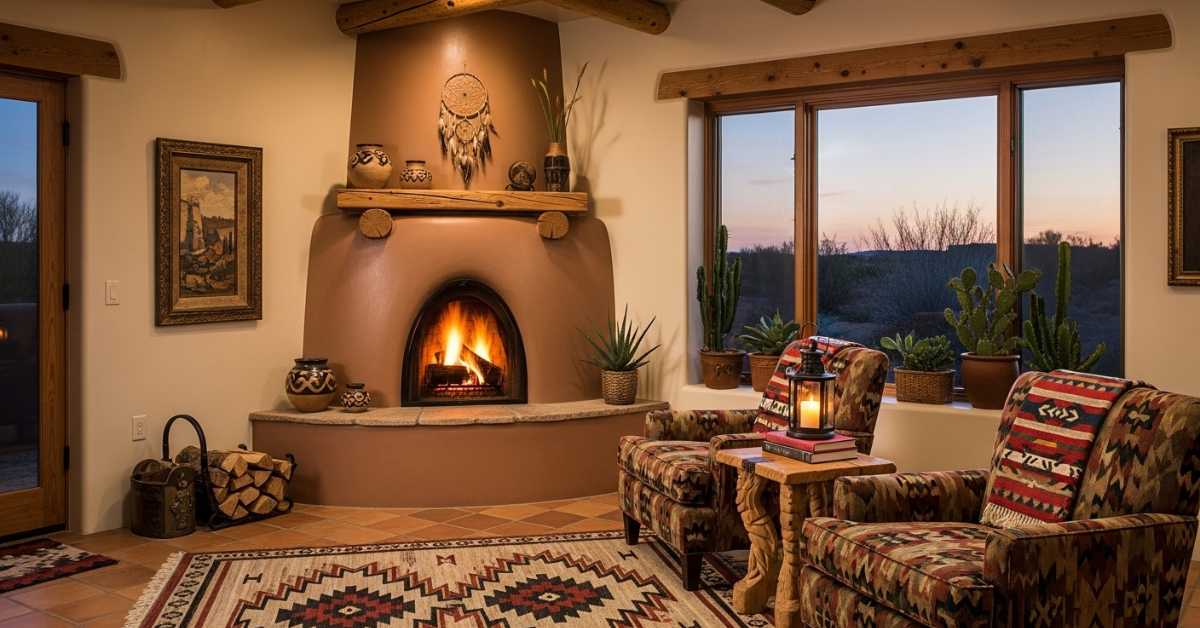
Nothing embodies authentic Arizona style quite like the kiva fireplace—a hallmark of Southwest adobe architecture. Instantly recognizable by their rounded, beehive-like structure and smooth plaster finish, kiva fireplaces trace their origins to Pueblo Native American traditions. In Arizona homes, they are most often tucked gently into a corner, serving as both a functional heat source and a sculptural focal point that infuses living spaces with warmth and distinctive desert character.
I have been seduced when searching for homes for my family by these fireplaces. They certainly were not part of Chicago homebuilding. I've seen homes with these fireplaces that otherwise wouldn't have worked for us (the homes were usually too small). I was trying to "fit us in" somehow - just for the fireplace!
More than just visual charm, kiva fireplaces serve a practical purpose in the region’s unique climate. The adobe or masonry materials soak up the heat of a wood or gas fire and then gradually radiate it back into the room, making chilly desert nights inviting and cozy.
Homeowners often personalize their kiva fireplaces with natural tiles, built-in bancos (seating), or rustic wood mantels, blending cultural heritage with modern comfort. This timeless element continues to shape the inviting spirit of Arizona living, bridging centuries of tradition with today’s Southwest lifestyle.
The Modern Era: A Testament to Innovation and Adaptability
Moving into the 20th century, Arizona's architectural landscape underwent another transformation, heralding the arrival of Mid-Century Modernism. This period was marked by a departure from ornamental designs towards a minimalist aesthetic that emphasized functionality, clean lines, and integration with the surrounding environment.
Iconic architects like Frank Lloyd Wright and Paolo Soleri left an indelible mark on Arizona's architectural heritage during this era. Wright's Winter home and studio, Taliesin West, nestled in the foothills of the McDowell Mountains in Scottsdale, is a masterpiece of organic architecture. Its seamless integration with the desert landscape, use of local materials, and innovative design principles make it a perennial source of inspiration.

Taliesin West - Frank Lloyd Wright's architectural school and winter home in Scottsdale
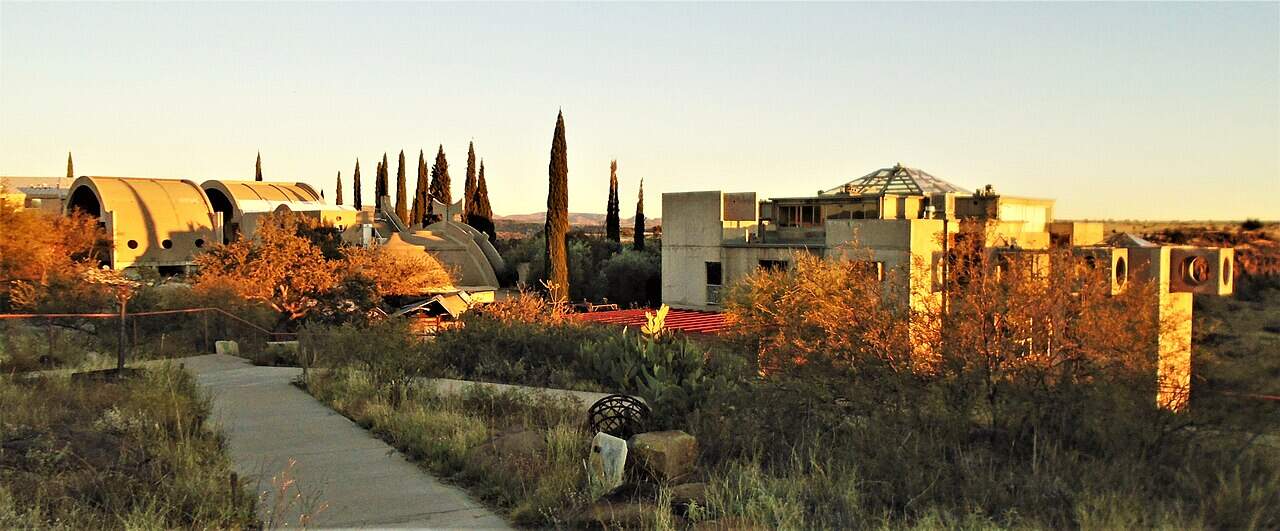 Photo of Arcosanti at the golden hour provided by Beyond My Ken on Wikimedia - license
Photo of Arcosanti at the golden hour provided by Beyond My Ken on Wikimedia - license
Paolo Soleri's Arcosanti is another exemplary model of Arizona's unique architectural lineage. Envisioned as an "urban laboratory", Arcosanti combines architectural innovation with ecological principles, aiming to demonstrate how urban conditions could be improved while minimizing the destructive impact on the earth. Its architecture is characterized by apses (half-dome structures) and large, terraced landscaping, creating a harmony between the built environment and the natural world. I've been to Taliesin West many times and never get tired of it, and I would love to visit Arcosanti someday.
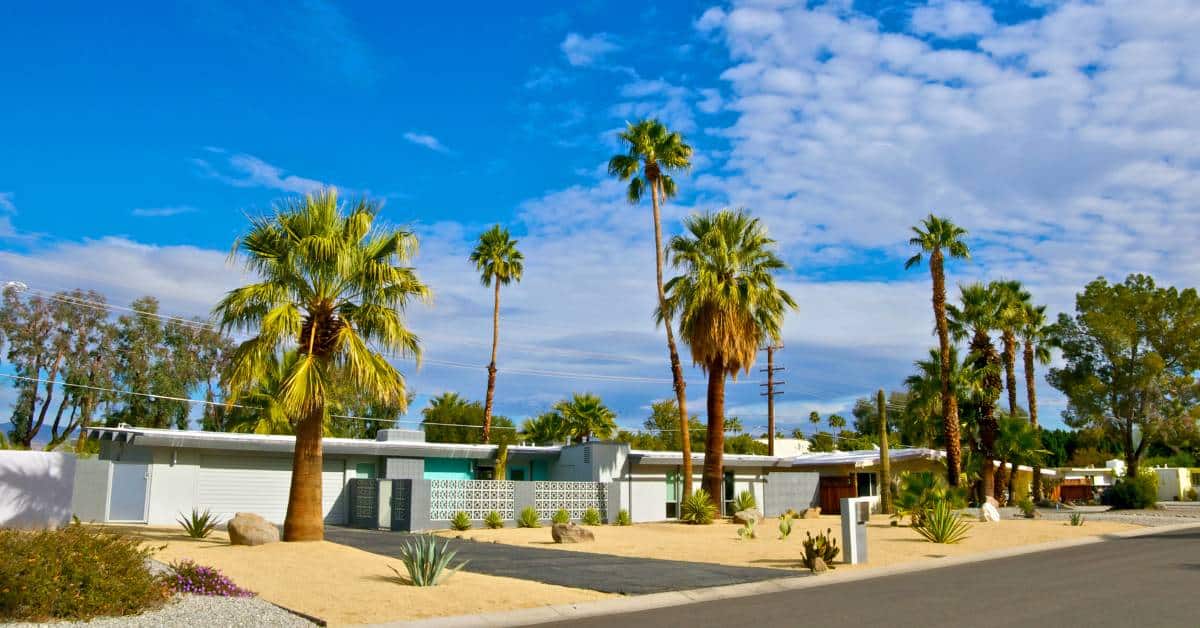
Mid-century Modern architecture has a strong presence in Arizona, particularly in the Phoenix metropolitan area. This style emerged in the post-World War II era and is characterized by its clean lines, open floor plans, and large windows that blur the boundaries between indoor and outdoor spaces. Mid-century Modern homes often feature flat or low-pitched roofs, exposed structural elements, and a mix of natural and industrial materials, such as wood, steel, and concrete. The interior of these homes typically showcases a minimalist aesthetic, with functional furnishings, bold colors, and an emphasis on natural light.
Contemporary Trends: Embracing Eclecticism and Sustainability
As we edge closer to the present day, Arizona's architecture continues to evolve, embracing an eclectic mix of styles that reflect its diverse culture and demographic. The proliferation of technology and a growing awareness of environmental sustainability have further shaped contemporary architectural practices. Today, you'll find a fascinating juxtaposition of ultra-modern, glass-encased skyscrapers rising in downtown Phoenix and quaint, Pueblo Revival-style homes that pay homage to the state's Indigenous roots.

Sustainability has emerged as a central theme in Arizona's contemporary architecture. Architects and builders are increasingly adopting green building practices, leveraging solar energy, and incorporating eco-friendly materials to reduce energy consumption and minimize the environmental footprint. Innovative designs now feature passive solar building designs, where the orientation of buildings, window placement, and other architectural elements are strategically planned to maximize natural heating and cooling.
Green architecture focuses on minimizing the environmental impact of buildings through the use of renewable energy, water conservation, and sustainable materials. Green homes in Arizona often incorporate features such as solar panels, rainwater harvesting systems, and xeriscaping (low-water landscaping). The interior of these homes may showcase recycled or repurposed materials, energy-efficient appliances, and natural ventilation techniques to reduce reliance on air conditioning.
The Popularity of Knockdown Interior Paint in Phoenix and the Southwest
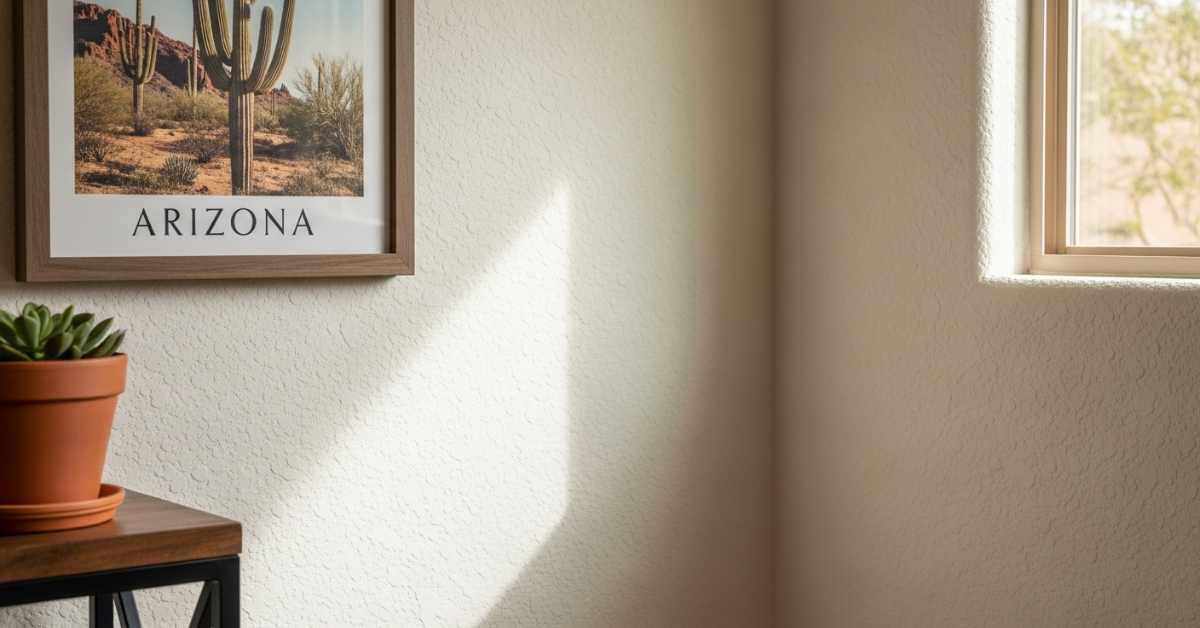
If you've spent any time in Phoenix homes, you've probably noticed those subtle, textured walls that look kind of like orange peel or splattered pancake batter. That's knockdown texture, and it's basically everywhere in the Southwest. But why is it so popular here?
This is something I immediately noticed when we visited my parents' home for the first time. It's another Arizona building feature that some native Arizonans couldn't care less about, but is interesting to those of us from the Midwest, or any area that doesn't utilize it. I love it, although I will admit that there is an area in our hall bathroom where the updated tub is obviously smaller than its predecessor, and the redone area on the one wall doesn't match the rest of the wall.
Unfortunately, the owners before us damaged the newer tub (they must have dropped something heavy and there is a bad epoxy fix and other dings), so at some point we're going to get a new tub. Maybe we can get that wall area fixed better. I've also noticed evident ceiling repairs in homes I've shown to buyers, as it must be difficult to match an existing knockdown surface.
First off, our desert climate is no joke. Those brutal summer temperatures and dry air can make walls crack and show imperfections like nobody's business. Knockdown texture is like a superhero for hiding these flaws. Instead of staring at every little dent or crack in your walls, the texture creates a consistent, slightly bumpy surface that masks these imperfections. Think about it like this: if you've got a plain white t-shirt with a small stain, it's super obvious. But if that shirt has a pattern or texture, you probably wouldn't even notice the stain. Same idea with knockdown walls.
Another huge reason? It's way more forgiving than smooth walls when it comes to maintenance. In a place where we're constantly tracking in dust and dealing with settling foundations (thanks, desert soil!), knockdown texture doesn't show dirt and small cracks as easily as smooth walls do. This means less touching up and repainting, which is a huge win when you're trying to keep your home looking fresh.
Knockdown texture is more affordable and faster to apply, which helps keep construction costs down in our rapidly growing area. Plus, let's be real - it just fits the Southwest vibe. The slightly rustic, organic look of knockdown texture complements the desert aesthetic we've got going on here.
So next time you're running your hand across those textured walls at home or at a friend's place, you'll know why they're everywhere in our corner of the desert. It's not just a trend - it's a practical solution that makes sense for our unique environment.
Arizona's Climate-Inspired Architecture: Sonoran Desert and Mountain Rustic Styles
Arizona's architectural diversity also includes a variety of local styles that have evolved in response to the state's unique climate and geography. For example, in the southern part of the state, you'll find the Sonoran Desert style, which is characterized by its use of native materials, such as stone and adobe, and its emphasis on outdoor living spaces. These homes often feature deep overhangs, shaded patios, and strategically placed windows to maximize natural cooling and ventilation. The interior of Sonoran Desert homes typically showcases a casual, rustic aesthetic, with exposed beams, natural stone accents, and a color palette inspired by the surrounding desert landscape.

In the northern part of Arizona, you'll find the Mountain Rustic style, which is influenced by the state's high-altitude forests and rugged terrain. This style is characterized by its use of natural materials, such as logs, stone, and timber, and its cozy, cabin-like atmosphere. Mountain Rustic homes often feature steep-pitched roofs, large fireplaces, and expansive windows that frame stunning views of the surrounding landscape. The interior of these homes typically showcases a warm, inviting ambiance, with plush furnishings, handcrafted accessories, and a color scheme that complements the natural beauty of the outdoors.
Exploring Arizona’s Artistic Legacy Through Architectural Design

Arizona's architectural landscape is also shaped by the state's thriving art and cultural scene. Many cities and towns throughout the state feature unique public buildings, museums, and cultural centers that showcase innovative and experimental design. For example, the Heard Museum in Phoenix, which is dedicated to the art and culture of the indigenous peoples of the Americas, features a striking contemporary exterior that incorporates elements of traditional Native American design. The interior of the museum showcases a rich collection of artifacts, textiles, and artworks displayed in a sleek, modern setting.
Similarly, the Musical Instrument Museum in Phoenix boasts a cutting-edge exterior design that features a sweeping, curved facade and a dramatic entrance plaza. Inside, visitors are treated to a state-of-the-art interactive exhibit space that showcases musical instruments and traditions from around the world. The museum's interior design incorporates advanced audio and visual technology, as well as thoughtful lighting and display techniques, to create an immersive and engaging visitor experience.
Final Thoughts
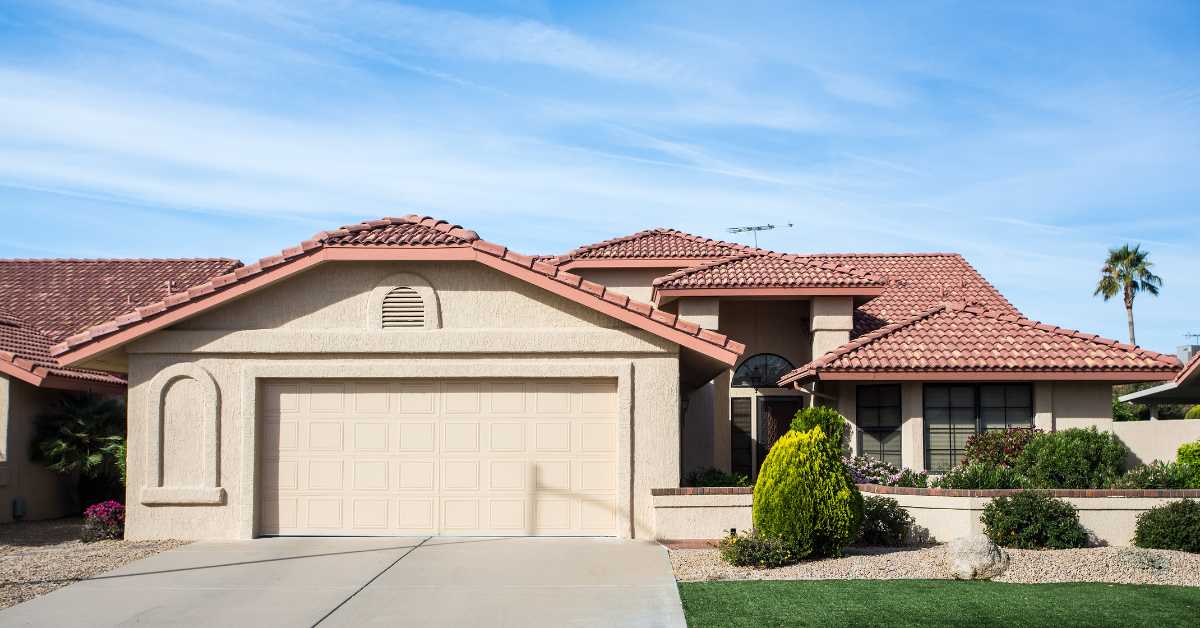
In conclusion, Arizona's building styles reflect the state's rich history, diverse cultural influences, and unique natural environment. From the earthy elegance of Pueblo Revival to the sleek simplicity of Mid-century Modern, and from the rustic charm of Mountain Rustic to the innovative experimentation of its public buildings, Arizona's architecture offers a fascinating glimpse into the state's past, present, and future.
Exploring this captivating landscape, you'll find endless opportunities to discover and appreciate the beauty, creativity, and functionality of Arizona's built environment. Whether you're strolling through the streets of a historic downtown, touring a cutting-edge cultural institution, or simply admiring the view from a mountaintop cabin, Arizona's architecture is sure to leave a lasting impression on your mind and heart.
Posted by Judy Orr on
.webp)
Leave A Comment